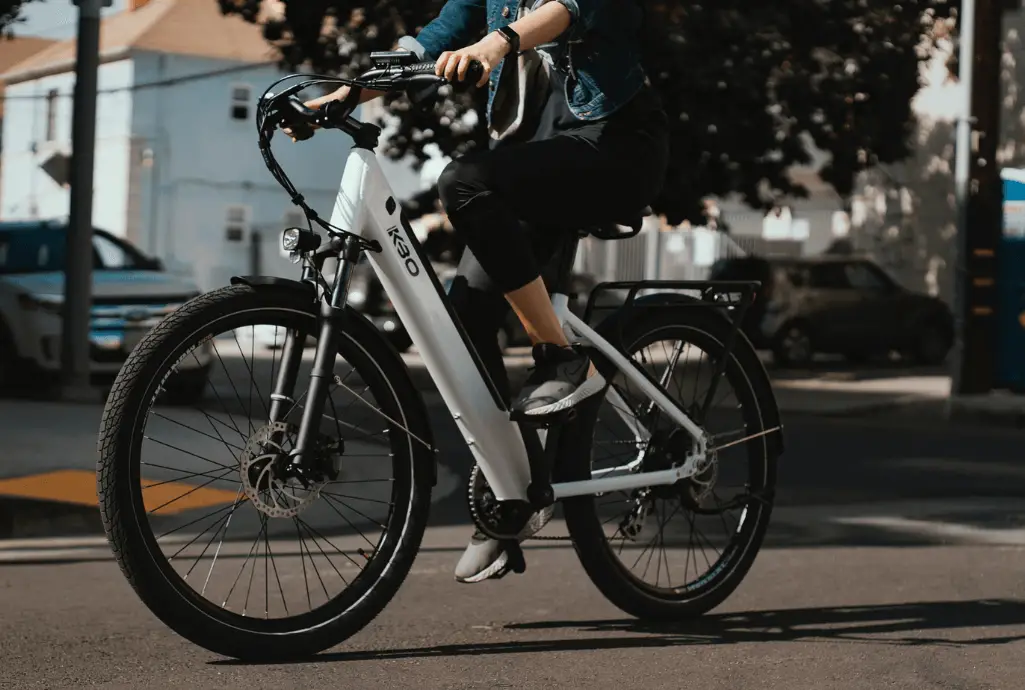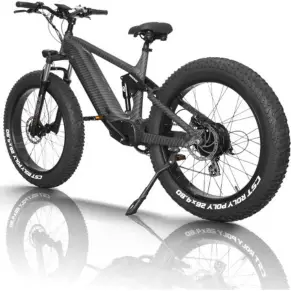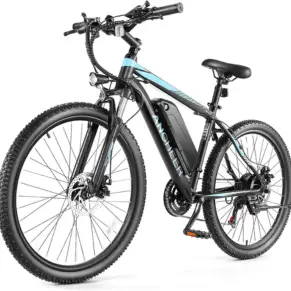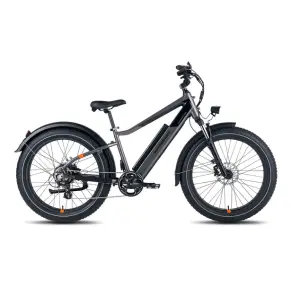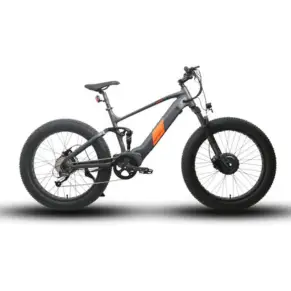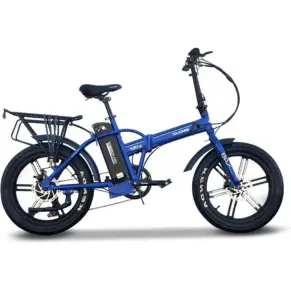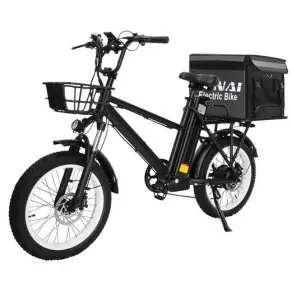Welcome to our guide on finding the best electric bike for big guys. We understand the unique needs and considerations of choosing an electric bike that offers comfort, support, and a great ride. Selecting an electric bike for heavy riders can occasionally pose challenges, as the weight factor can impact the overall range the electric bike can cover.
In this article, we’ll highlight the best electric bike for big guys, specially selected to make your biking experience enjoyable and hassle-free. Let’s dive in!
Table of Contents
Himiway Cobra Electric MTB
The Himiway Cobra Electric Mountain Bike (MTB) is an e-bike that combines power, reliability, and comfort in one impressive package. Engineered for the adventurer at heart, this e-bike is perfect for larger riders seeking a rugged and reliable ride.
Pros
Powerful Motor: Equipped with a 750W brushless gear hub motor, the Himiway Cobra offers a powerful boost to easily handle different terrains, even with a heavier rider.
Robust Frame: The Cobra is designed with a high-strength, 6061 aluminum frame that can comfortably accommodate riders up to 350 lbs.
Wide Tires: With 4-inch wide fat tires, the bike provides excellent stability and grip on various surfaces, offering a smoother ride for heavier riders.
Adjustable Saddle: The adjustable saddle allows riders to find the most comfortable position according to their height and preference, enhancing the overall riding experience.
Cons
Battery Performance: Like other e-bikes, the battery’s performance may be slightly lower for heavier riders, especially on steep hills or longer rides.
Size: The Cobra is a full-sized bike and may not be suitable for those with limited storage space or who need to transport it frequently.
Limited Suspension Fork: The bike lacks a rear suspension, which might lead to less comfort on rough trails. Limited front suspension fork movement can also decrease comfort levels.
Price: The Himiway Cobra is priced higher than some competitors, potentially making it less accessible to some buyers.
Key features
The Himiway Cobra Electric MTB offers an excellent balance of power, durability, and comfort. While it’s not the most affordable option on the market and may present some limitations in suspension and battery performance under heavy load, its sturdy frame, powerful motor, and wide tires make it a worthy consideration for larger riders. The investment will hold up well to rigorous use and deliver a satisfying riding experience.
Ancheer Mountain Bike for Heavy Riders
The Ancheer Mountain Ebike is certainly one of the best bikes for heavy riders. Its sturdy construction, powerful motor, and well-designed features make it an ideal choice for larger individuals seeking a robust and reliable e-bike for both on and off-road adventures.
Pros
Robust Frame: Constructed from high-strength carbon steel, this bike frame construction can easily accommodate heavier riders, offering durability and stability.
Powerful Motor: Equipped with a 500W motor, it can easily power through challenging terrains and steep inclines, regardless of rider weight.
Adjustable Saddle: The saddle height can be adjusted for comfort, allowing for a more customized riding experience.
Versatility: Its adaptable design suits various terrains, from city streets to off-road trails.
Cons
Weight of the Bike: The sturdy construction results in a heavier bike, which can be challenging for transportation or carrying.
Battery Life: While the battery life is decent, heavier riders might find it drains more quickly, especially on hilly terrains or when using the highest power setting.
Limited Adjustability: Besides the saddle height, a few options exist for adjusting the bike to better suit the rider’s comfort.
Assembly: Some assembly is required, which might be difficult for bike users.
Key features
The Ancheer Mountain Ebike for Heavy Riders is an excellent choice for larger individuals seeking a durable and reliable e-bike. It offers a sturdy frame, powerful motor, and versatile riding, allowing enjoyable rides in various environments. Despite a few drawbacks, such as the bike’s weight and limited adjustability, its overall design and features make it a worthy consideration for heavier riders.
Rad Power Bikes – RadRover 6
The RadRover 6 from Rad Power Bikes is a strong contender in e-bikes, specifically crafted with heavy riders in mind. This bike powerhouse is renowned for its robust construction and the ability to comfortably handle varying terrains, assuring larger riders of a stable, secure, and smooth ride.
Pros
High Weight Capacity: With a substantial weight limit of 275 lbs, the RadRover 5 is perfectly suited to support larger riders, promising safety and durability.
Sturdy Fat Tires: Its 4″ wide fat tires provide increased stability and excellent shock absorption, crucial for heavier riders, ensuring a comfortable ride even on more challenging terrains.
Powerful Motor: Powered by a robust 750W geared hub motor, the RadRover 5 has no issues propelling larger riders up inclines or maintaining a consistent max speed.
Adjustable Saddle: Its saddle is designed for optimal comfort, enabling bigger riders to find a seating position that best suits their body frame.
Cons
Hefty Weight: The RadRover 6 is quite a heavy bike, which could pose transportation difficulties, especially if you need to carry it upstairs or load it into a vehicle.
Limited Colors: Its limited color range might be a minor issue for those seeking more customization or aesthetic options.
Higher Price Point: While the price reflects its quality and features, it might still be steep for some potential riders.
Long Charging Time: The battery can recharge for up to 6 hours, which might be inconvenient for those who want to use the bike frequently or for longer distances.
Key features
The RadRover 6 stands tall in the e-bike world, with its specific features designed to cater to the needs of heavier riders. Its high weight capacity, broad and sturdy tires, robust motor, and comfortable saddle collectively work towards providing a secure, comfortable, and enjoyable biking experience.
Despite its heavier weight and longer charging time, it is a small price to pay for its quality and performance. For larger riders seeking an e-bike that can deliver reliability, power, and comfort, the RadRover 6 is undeniably a fantastic investment.
Eunorau Fat-AWD
The Eunorau Fat-AWD is an electric bike designed with versatility and comfort in mind. Its robust build and powerful dual motors make it a strong contender for larger riders who require a sturdy and reliable e-bike.
Pros
Dual Motors: The bike has two motors (350W rear and 250W front), providing plenty of power to handle various terrains, even for heavier riders.
Large Weight Capacity: With a maximum load capacity of 330 lbs, the Eunorau Fat-AWD is suitable for larger individuals.
Fat Tires: The 26″ x 4″ fat tires provide excellent stability and can handle various terrains, providing a smooth and comfortable ride.
Extended Range: The 48V/15.6Ah battery offers a substantial range of up to 50 miles per charge, which is quite impressive.
Cons
Weight of the Bike: The bike weighs approximately 73 lbs, which might be difficult for some to maneuver when not in use.
Complicated Assembly: Some buyers have reported that the assembly instructions could be clearer, which may require extra time or professional help.
Pricey: The Eunorau Fat-AWD has a higher price tag, which may only suit some people’s budget.
Limited Availability: Due to high demand, this bike often goes out of stock, making it a bit challenging to purchase.
Key features
The Eunorau Fat-AWD is a powerful and versatile e-bike that can easily handle heavier riders’ needs. The bike’s large weight capacity, powerful dual motors, and fat tires make it a strong choice for larger individuals. Despite being a bit heavier and having a higher price tag, its outstanding features make it a worthy investment for big guys looking for a sturdy, reliable, and powerful e-bike.
Emojo Lynx Pro Ultra
The Emojo Lynx Pro Ultra is a folding fat tire e-bike designed with a keen eye on durability and rider comfort. Its robust construction and thoughtful features make it an attractive option for the bigger riders seeking a reliable and versatile e-bike.
Pros
Foldable Design: Despite its robust frame, the bike folds up compactly for easy storage and transportation, making it an ideal choice for urban commuters.
Powerful Motor: The bike features a 500W DC brushless motor with ample power to handle various terrains and inclines, even with heavier riders.
Fat Tires: The 4-inch wide fat tires provide excellent traction and stability, offering a safer and more comfortable ride for larger individuals.
Durable Frame: The high-strength steel frame can support riders up to 330 lbs, providing a sturdy and reliable ride.
Cons
Battery Life: The bike’s battery life may be shorter when carrying heavier riders, especially over long distances or steep terrains.
Weight: The bike is quite heavy due to its sturdy construction, making it difficult to carry when folded.
Limited Adjustability: Although the seat height is adjustable, other parts, like the handlebars, lack adjustability, which might affect comfort for some riders.
Higher Price Tag: The Emojo Lynx Pro Ultra comes at a higher price than other best electric bikes, which may be outside everyone’s budget.
Key features
The Emojo Lynx Pro Ultra stands out with its foldable design, powerful motor, and fat tires, making it a solid option for bigger riders. While the battery life could be a concern for some, and the weight might make it less portable, the overall quality, durability, and performance make it worth considering. Remember that this bike is an investment, and its higher price tag reflects its superior build and features.
GUNAI 1000W Electric Bike
The GUNAI 1000W Electric Bike is designed for performance. It features a potent motor and a rugged build, making it ideal for riders of larger stature. Its design prioritizes durability, power, and comfort, making it an excellent choice for heavier riders.
Pros
Powerful Motor: With a 1000W motor, the GUNAI provides ample power to comfortably accommodate larger riders, even on inclines or difficult terrain.
Sturdy Frame: The bike’s frame is made of durable and lightweight aluminum alloy, ensuring it can support heavier weights without compromising performance.
Fat Tires: Equipped with 26″ x 4″ fat tires, the bike offers excellent traction and stability across various surfaces – an added advantage for bigger riders.
High Weight Limit: With a weight limit of 440 lbs, it’s a suitable choice for bigger individuals.
Cons
Heavy: Weighing around 66lbs, it could be challenging to handle off the road, especially for riders with limited strength.
Expensive: This model comes with a higher price tag, which might deter some potential buyers.
Complex Assembly: Some users reported difficulties with assembly due to inadequate instructions.
Battery Life: Though the bike offers a decent range, frequent high-power usage can deplete the battery quickly.
Key features
The GUNAI 1000W Electric Bike is a robust, reliable, and powerful e-bike for heavier riders. Its high weight limit, robust frame, and powerful motor make it a formidable option for performance and durability. While it may be heavier and requires a substantial investment, its capabilities, especially for larger riders, make it a worthy contender in the e-bike market.

Buying Guide: What to Consider When Looking for Best Electric Bike For Big Guys
What is the weight limit of the e-bike?
The weight limit of an e-bike varies from one model to another. Still, most models generally accommodate riders up to 220-300 lbs. However, specific models are designed to handle more weight, some exceeding 400 lbs or more. Be sure to check the manufacturer’s specifications before purchase.
What type of frame is best for a heavier rider?
A heavier rider needs a strong and durable frame. Steel and aluminum are generally more robust and are good options for larger riders. Aluminum, being lighter, reduces the bike’s overall weight, which could be an advantage considering the added weight of the battery and motor.
How does rider weight affect battery life?
Rider weight can significantly impact an e-bike’s battery life. A heavier rider means the motor has to work harder, draining the battery faster. On flat terrains, the effect might be insignificant. Still, on hilly terrain or when riding against strong winds, a heavier rider may notice a noticeable battery life decrease.
What are the best e-bike brands for heavier riders?
Brands such as Rad Power Bikes, Addmotor, and Emojo manufacture e-bikes that handle heavier weights. These brands offer models with higher weight limits, sturdy frames, powerful motors, and wider tires for stability.
What kind of tires should an e-bike for a heavier rider have?
When choosing an e-bike, the tire size and type play a crucial role in the overall performance and comfort of the ride, especially for heavier riders. One of the essential attributes to consider is tire width, which significantly influences the stability and weight distribution of the bike.
For riders carrying more weight, wide tires are the preferred choice. Wide tires, often seen on cruiser and fat-tire bikes, are broader than standard tires, usually exceeding 2 inches in width. The added width provides a larger contact surface with the ground, which offers two main benefits.
First, a wide tire gives better stability, especially at slower speeds or when taking corners. It offers a secure and balanced ride, reducing the risk of tipping or losing control. This attribute is essential for heavier riders, who may feel unstable due to their higher center of gravity.
Second, wide tires distribute the rider’s weight more evenly over a larger area. This reduced pressure on the ground means less stress on the tire and, subsequently, on the bike’s frame and components. It can result in fewer punctures, less tire wear, and improved bike longevity overall.
Fat tires take the concept of wide tires a step further. These tires can exceed 4 inches in width and are often seen on specialized bikes designed for off-road use on sand, snow, and other soft or uneven surfaces. The unique advantage of fat tires is their unrivaled traction, a boon for heavier riders who might feel uncertain on loose or slippery terrain. The bike can grip the ground firmly with fat tires, offering a confident and controlled ride, regardless of the surface beneath.
In conclusion, wider or fat tires could significantly enhance the e-biking experience for a heavier rider, offering improved stability, superior weight distribution, and exceptional traction. However, balancing these advantages with the increased rolling resistance and potential for a less efficient ride that wide tires can bring is essential. A professional bike advisor can provide guidance to find the perfect balance based on the rider’s weight, terrain, and personal preferences.
How does a heavier rider affect the bike’s performance?
When a rider is heavier, it’s essential to understand how this may impact the performance of an e-bike, and it’s a topic worth paying attention to when selecting the right e-bike model.
One of the first areas affected is the overall speed (top speed included) and range of the e-bike. A heavier rider will demand more from the electric motor, which, in turn, requires more power from the battery. This increased power usage can reduce the range – the distance the e-bike can travel on a single battery charge. This reduction can be more pronounced on uphill climbs where the motor has to work even harder.
Secondly, the weight of the rider directly affects the bike’s acceleration. A heavier rider might find that the e-bike accelerates slower than it would with a lighter rider. This is primarily due to the additional power required to propel the extra weight forward.
Braking distance is another aspect of e-bike performance influenced by rider weight. Heavier riders may need more distance than lighter riders to come to a complete stop. This is due to the increased momentum that needs to be halted. Therefore, high-quality mechanical disc brakes are essential for heavier riders to ensure safe and effective stopping power.
The durability and longevity of e-bike components can also be impacted by rider weight. More weight puts more strain on the e-bike’s frame, tires, and components like the chain and gears. Over time, this can lead to increased wear and tear. Therefore, a bike with robust construction and high-quality components is highly recommended for heavier riders.
Lastly, the bike’s handling characteristics might change with a heavier rider. A bike’s maneuverability, balance, and how it responds to steering input can feel different to heavier riders. A bike with a sturdy frame and balanced design can counteract these effects, providing a smoother and more predictable ride.
In conclusion, while a heavier rider can impact the e-bike’s performance, many of these challenges can be managed by carefully selecting an e-bike designed to accommodate higher weights. Models with a robust frame, high-quality components, powerful motors, and larger batteries can provide heavier riders a safe, comfortable, and enjoyable riding experience.
What kind of saddle is most comfortable for a heavier rider?
Regarding comfort on an e-bike for a heavier rider, the saddle (or seat) plays a significant role. It’s one of the three points where your body makes contact with the bike, and it supports a good portion of your weight, so choosing the right one is essential.
For heavier riders, a wider saddle is often the best choice. These designs provide a more significant contact area, distributing the rider’s weight over a larger surface. This distribution helps to reduce pressure points, which can lead to discomfort or numbness during longer rides.
In addition to being wider, many saddles designed for comfort include extra padding or special materials like gel inserts. This additional cushioning can significantly enhance comfort, absorbing shocks and vibrations from the road, which would otherwise be transmitted directly to the rider. This shock absorption is particularly beneficial for heavier riders as more weight can equal more force and vibration.
Ergonomics is another important aspect. Some saddles are ergonomically designed with a recessed center or a “cut-out” section to alleviate pressure on sensitive areas, which can benefit larger riders.
It’s worth noting that saddle comfort can be a very individual thing. What works for one person might not work for another. Therefore, it is worth experimenting with a few different saddle types or consulting with a electric bicycle fitting specialist to find the best fit for you.
Lastly, pairing a comfortable saddle with appropriate cycling shorts is crucial for optimum comfort. Padded cycling shorts can provide an extra cushioning layer and reduce friction between the body and the saddle, making for a much more pleasant riding experience, especially for heavier riders.
In conclusion, while a wider, cushioned saddle will likely provide the best starting point for heavier riders, the most comfortable option will depend on individual body shape, riding style, and personal preference. Finding the right saddle can significantly improve your e-bike experience, making rides more enjoyable and comfortable.
What’s the ideal motor power for a heavier rider?
A motor with higher power (between 500 and 1000W) is ideal for heavier riders. A powerful motor ensures the bike can efficiently support the rider’s weight, especially in hilly terrain or when carrying an additional load.
Is there a benefit to using a fat tire e-bike for heavier riders?
Yes, fat tire e-bikes offer benefits for heavier riders. They provide better stability, absorb bumps better, and can easily handle different terrains, making the ride smoother and more comfortable.
Can the e-bike’s suspension system be adjusted for heavier riders?
E-bike suspension systems are critical in maintaining comfort and control on various terrains. For larger riders, having a suspension system tailored to handle their weight is especially crucial.
Most modern e-bikes come equipped with adjustable suspension systems. These systems often use air or coil springs that can be adjusted to change the suspension’s stiffness or “spring rate.” A higher spring rate, achieved by increasing the air pressure in an air spring or using a stiffer coil spring, results in a firmer suspension. For heavier riders, a firmer suspension can be beneficial as it will compress less under their weight, providing better support and maintaining the bike’s handling characteristics.
Adjusting the suspension isn’t just about stiffness, though. Most quality e-bikes also offer “damping” adjustments. Damping controls how quickly the suspension compresses and rebounds after an impact, affecting comfort and control. Heavier riders may require more damping to prevent the suspension from bouncing back too quickly after absorbing a bump.
Some e-bikes also provide the option to adjust the suspension’s “sag,” which is the amount the suspension compresses under the rider’s weight while the bike is stationary. For heavier riders, increasing the sag can provide a more comfortable and stable ride, as it allows the suspension to work more effectively over bumps and helps keep the tires in contact with the ground for better traction.
However, adjusting an e-bike’s suspension to suit a heavier rider can be complicated. It often requires trial and error to find the perfect setup. Most manufacturers provide baseline recommendations for suspension setup based on rider weight, which can be a helpful starting point. From there, riders can fine-tune their suspension settings based on personal preferences and their specific conditions.
If you’re unsure how to adjust your e-bike’s suspension, consider consulting with a professional at a bike shop. They can help dial the perfect setup for your weight and riding style, ensuring a comfortable and enjoyable ride.
In summary, an adjustable suspension system on an e-bike is a valuable feature for heavier riders. With some fine-tuning, it can provide a comfortable and controlled ride tailored to a larger rider’s specific needs and preferences.
How fast can an e-bike go?
The speed of an e-bike can vary based on the model and motor power. Typically, e-bikes can reach speeds of 20-28 mph. However, remember that rider weight can affect the maximum achievable speed.
Frequently Asked Questions (FAQ)
What type of maintenance does an e-bike require?
An e-bike, like any other bike, requires regular maintenance to keep it in good working order. However, there are some unique aspects to e-bike upkeep due to the electrical components. In addition to standard bike care – such as tire pressure checks, brake inspections, and gear adjustments – e-bikes require battery care and occasional motor system check-ups.
The battery is vital to your e-bike and should be charged according to the manufacturer’s instructions. Keeping the battery charged is usually recommended, even when the bike is not in use, to maintain its overall lifespan. Similarly, storing the battery in a dry, cool place would be best to protect it from extreme temperatures.
The electric motor system should be checked regularly for any wear or damage. This can usually be done visually, but any unusual noises or performance issues could indicate a problem that needs professional attention.
Heavier riders may need to pay extra attention to parts like the tires, hydraulic disc brakes, and suspension system, as these will experience more strain. Regular checks and timely replacements will ensure a safer, smoother ride.
Can I upgrade the components of the e-bike to suit my weight better?
Absolutely! One of the advantages of e-bikes is their modularity, meaning that many components can be upgraded to better suit your needs. For heavier riders, these upgrades include a more cushioned saddle, sturdier pedals, wider tires, or a more robust suspension system.
When considering upgrades, it’s essential to ensure the new components are compatible with your e-bike and won’t adversely affect its performance or safety. It’s often best to consult with a bike professional when considering significant upgrades to ensure the best outcome.
What is the lifespan of an e-bike’s battery?
The lifespan of an e-bike’s battery largely depends on its type, quality, and how well it’s cared for. On average, a high-quality e-bike battery should last between 3-5 years or 500-1000 full-charge cycles, whichever comes first.
Remember that the battery range – how far you can go on one charge – can be affected by rider weight, terrain, weather, and the level of motor assistance used. Heavier riders may find that the battery depletes more quickly due to the additional power required to move the extra weight.
To maximize battery lifespan, follow the manufacturer’s care instructions. This generally involves keeping the battery charged, avoiding extreme temperatures, and storing it properly when not in use. Regular use of the e-bike also helps maintain battery health. If you notice a significant decrease in battery performance, consider a replacement.
Remember, when it comes to e-bikes, maintenance and component upgrades are just as important for heavier riders as for cyclists. Proper care and a few tailored enhancements can ensure a safe, comfortable, and enjoyable e-biking experience.

